Inside the Hells Angels: What you need to know about the world’s biggest outlaw bikie gang
The Hells Angels is the world’s biggest outlaw bikie gang with an infamous rap sheet that includes brutal murders, large-scale drug trafficking, chilling standover tactics and jury tampering.
Crime in Focus
Don't miss out on the headlines from Crime in Focus. Followed categories will be added to My News.
The Hells Angels are the world’s biggest outlaw bikie gang, with a larger-than-life presence in dozens of countries around the world.
The club has trademarked its skull logo and taken legal action for infringements.
They started in California in 1948 and its first international chapter was in Auckland New Zealand in 1961. The first Australian clubs were admitted in the 1970s.
There is no international or national boss. Each chapter has a president, vice president, sergeant-at-arms, secretary/treasurer, road captain, security officer.
Full members wear two “rocker” patches on their backs: A curved “Hells Angels” patch across the top, and a second across the bottom that identifies their chapter or territory.

Members sporting a “Filthy Few” patch are said to have killed for the club, although it has been argued by Hells Angels lawyers in court that the patches are for those who party the hardest.
A diamond “1%” patch signifies the claim that one per cent of motorcyclists are “outlaws” while the rest are law-abiding citizens.
Only “white males” can join, but this is not restricted to any one ethnicity
“Hang-around” is label given to those allows to attend club events and have minor involvement with the club. After a year they may be nominated as a prospect.
“Prospects” don’t have voting rights but after another year can be voted in as a full member. They can’t wear the top “rocker” patch until then and must wear a patch that identifies them as a prospect.
“Fully patched” members are full members with voting rights. The club’s fully patched members vote a prospect to this status. Only full members can wear all club patches including the “Hells Angels” patch, or “rocker”.
Other bikie gangs
THE COMANCHERO: THE MOST VICIOUS BIKIE CLUB
THE BANDIDOS: HOW THEY WERE BORN
THE REBELS: POWER VACUUM WEAKENED THEIR EMPIRE
THE FINKS: THE RULES THEY HAVE TO FOLLOW

The world’s biggest
The Hells Angels are the world’s biggest outlaw bikie gang, with a larger-than-life presence in dozens of countries around the world.
But don’t let their ubiquity fool you into a false sense of security — their motto, after all, is: “Three can keep a secret if two are dead”.
Their infamous rap sheet in Victoria includes brutal murders, large-scale drug trafficking, chilling standover tactics, jury tampering, sex crimes and dozens of other heinous offences that have embroiled AFL stars, innocent mothers and teenage girls.

But the gang was originally formed in California in 1948, when a group of WWII veterans started riding together as they struggled to cope with their return to civilian life.
It wasn’t long before they fell into organised crime — the Hells Angels started dealing LSD in the 1960s and became increasingly violent.
At a Rolling Stones concert in 1969, some Hells Angels — who had been hired by the Stones to provide security in exchange for free beer — stabbed and kicked an 18-year-old fan to death.
Angered that Mick Jagger refused to use their services again after the bloody incident, the gang was believed to have ordered a contract on Jagger’s life, prompting an assassination attempt that narrowly failed.
In 1974, the Hells Angels hired a PR group to repair their reputation as tough but fair men.
They bought billboards to promote a “No Hope with Dope” message — in the background, however, they were setting up clandestine methamphetamine labs along America’s west coast.

Hells Angels arrive down under
The Hell Angels expanded to Australia in 1975, establishing chapters in Melbourne and Sydney.
In 1980, founding members Peter Hill and Raymond Hamment flew to California and visited Oakland chapter president Sergei Walton in prison.
He taught them how to make amphetamines and later posted a precise recipe, paving the way for the drug’s introduction into Australia.
The Hells Angels rented a farmhouse in Melbourne’s northeast, near Hurstbridge, where they produced amphetamines in 50 pound (22.7kg) batches worth $600,000 on the street.
The gang also shipped about 200 litres of phenylacetic acid to their American associates in Golden Circle pineapple cans, enough to make about $55 million worth of amphetamines.
But their drug lab was raided by police in 1982, sparking an internal feud over the gang’s operations that led to about 40 violent incidents.
Hill turned on the gang and co-operated with police, prompting the Hells Angels to put a contract on his life.
Another bikie, Roger Biddlestone, who also turned on the gang, allegedly had his arm fractured in 33 places when he was beaten with iron bars.
Nine Hells Angels were charged with conspiring to murder Hill and Biddlestone, but Biddlestone refused to testify. The charges against his former club mates didn’t stick, and he was convicted of contempt of court.
Several bikies were convicted on drug charges in 1987, but only after three trials — the first was scrapped when a juror accepted a $10,000 bribe, and the Oakland Angels had to send $50,000 to help with legal costs.
A major police investigation, codenamed Omega Two, had tracked the gang’s movements ferociously, prompting James Paton “Jim-Jim” Brandes — an American-based Hells Angel who tried to kill a US police officer — to try to assassinate a detective on the case.
He flew to Melbourne but was immediately deported.
Hells Angel meets Mr Death
During this period, a former president of the Nomads chapter — the Hells Angels’ roaming enforcers in Victoria — suffered a bloody end.
Anton Kenny was kicked out of the Angels in 1983 for co-operating with police.
Three years later, his body was found in a drum near Yarra Boulevard, but this time, it wasn’t the bikies killing their own.
He had been shot five times by notorious criminal Dennis “Mr Death” Allen, who cut off Kenny’s legs and buried him in the drum with concrete and lime.
Drug operations continue
In the 1990s, the Hells Angels used Victoria as a key distribution network for what was described in court as the nation’s largest amphetamines ring.
A 1995 raid in Brisbane netted 178kg of amphetamines with a retail value of about $160 million.
Young mother murdered
One of the most shocking stories involving the Hells Angels unfolded in 1999, when Bendigo mother Vicki Jacobs was shot six times while sleeping next to her six-year-old son, Ben.
She had given evidence that helped convict her ex-husband Gerald David Preston of a double murder in Adelaide, and her testimony implicated the Hells Angels in hiring Preston for the killings.
Police described the murder of Jacobs as “one of the most calculated, brutal crimes we have ever seen.”
The Hells Angels’ Thomastown chapter was raided a month after the murder, with police using a bulldozer to crash through the fortified entrance. But no charges were laid.
A coronial inquest in 2004 declared Preston was the prime suspect and pointed to the involvement of Terrence Tognolini, an enforcer in the Melbourne-based Nomads who is now in jail for other crimes.


AFL players caught up in kidnapping
In 2005, three Hells Angels kidnapped Brendan Schievella from a bar in Ivanhoe, in an incident that entangled three prominent footballers who were at the venue.
Schievella was missing for more than four hours, as the gang bashed him and dangled him off an eight-metre walkway.
Carlton players Heath Scotland, Lance Whitnall and Nick Stevens were at the bar when Schievella was abducted, and co-operated with police.
The three Hells Angels were jailed in 2007 but the motive for the attack — in which the victim’s toe was severed — was never revealed.

Sergeant-at-arms in trouble
Peter “Skitzo” Hewat, sergeant-at-arms of the Angels’ East County chapter in Victoria, appeared in court in 2005 for allegedly helping cover up an accident involving East County president Stephen Rogers.
He was seen writing down the address of a key witness — which was inadvertently revealed in court — before police intervened.
Hewat was later given a suspended sentence for trying to intimidate a witness to the accident.
In December 2005, Hewat won a six-figure settlement from Victoria Police over their seizures of his property.
Hells Angel shocks Melbourne
Melbourne CBD killer Christopher Wayne Hudson’s defection from the Finks to the Hells Angels caused a serious ruckus during 2006.
He was recruited to help the Hells Angels muscle into the Gold Coast drug trade.
This enraged the Finks, sparking a violent brawl at a kickboxing tournament where Hudson was beaten and shot twice.

Two other bikies were shot and two were stabbed in what became known as the “Ballroom Blitz”.
In 2007, Hudson horrified Melbourne when he shot three people on a busy morning in the CBD.
Fuelled by drugs and alcohol, he was fighting with girlfriend and stripper Kaera Douglas when two bystanders — solicitor Brendan Keilar and backpacker Paul de Waard — stepped in to help her.
Hudson opened fire, killing Keilar and seriously injuring Douglas and de Waard.
Witnesses said Hudson tried to shoot himself but had run out of bullets. He fled before eventually surrendering after a national manhunt.
Didak ‘should have gone to the police’
It soon emerged that a week prior to the shooting, Hudson met Collingwood star Alan Didak at strip club Spearmint Rhino, where the pair drank together.
Hudson then drove Didak in his Mercedes to a Hells Angels clubhouse, firing shots out the window of the car in Campbellfield.
Didak said he feared for his life but stayed on to drink at the clubhouse.

Shooting victim Brendan Keilar’s mother said Didak could have saved her son’s life by reporting the incident.
“If he had gone to police with information about the shootings, it’s possible Brendan would still be alive,” said Moya Keilar.
“He is obviously not fussy about who he associates with.”
Hudson is now serving at least 35 years behind bars.
Sex creep kicked out of gang
In 2007, enforcer Terrence Tognolini was kicked out of the Hells Angels after they learnt he had been feeding drugs to teenage girls and having sex with them.
Tognolini’s tattoos were blacked out and he was savagely beaten, before he was dumped in wheelbarrow and tipped onto the street outside the gang’s Thomastown clubhouse.
Six months later, police arrested him on blackmail and arson charges — he had spent years terrorising his business rivals in the hydroponics industry — and a series of sex offences.
Tognolini, who remains a person of interest in the murder of Vicki Jacobs but has never been charged, was sentenced to a minimum eight years’ jail in 2010.
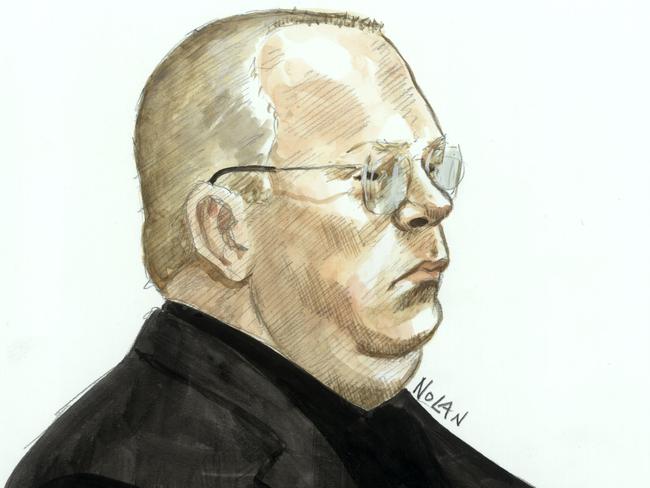
Bikies brawl at Sydney Airport
A deadly brawl between the Hells Angels and the Comanchero at Sydney Airport in 2009 renewed public fears about bikies.

After a flight from Melbourne landed, carrying members of both gangs, more than a dozen men starting fighting near the busy check-in counters.
Hells Angel Anthony Zervas was beaten to death by metal poles; 15 men were later charged over the incident.
A week later, Zervas’ brother Peter barely survived being shot up to eight times outside his mother’s house.
Desperate to restore their reputation, US Hells Angels bosses issued a decree that local members shoot any Comanchero “on sight”, sparking fears of an all-out bikie war.
But NSW Police responded with a strike force that made 400 arrests and laid over 800 charges in the six months following the airport fight.
Hells Angels in western suburbs feud
In 2010, the Hells Angels became embroiled in a bloody family feud between the Chaouk and Haddara families in Melbourne’s west.
The murder of family patriarch Macchour Chaouk prompted a large turnout of Hells Angels at his funeral, where they embraced Chaouk’s son Omar.
Another of Chaouk’s sons was allegedly an associate of the bikie gang.
Melbourne CBD killer Christopher Hudson also posted a death notice for Chaouk in the Herald Sun.
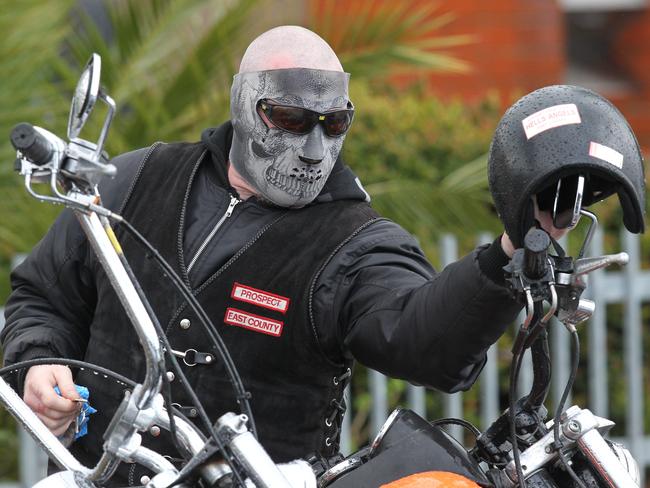
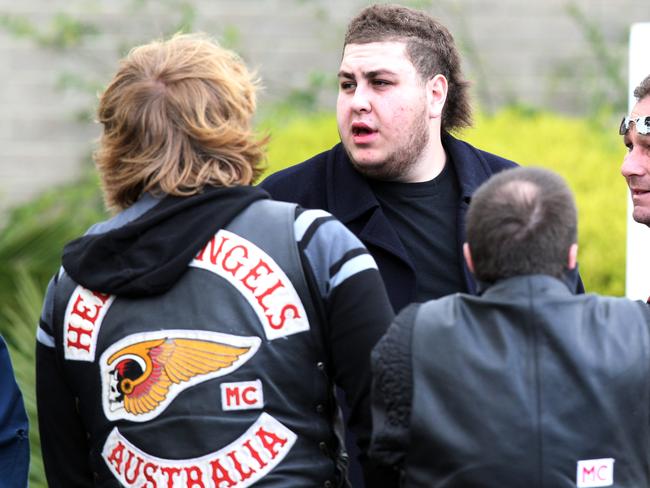
But the alliance between the Chaouk’s and the Hells Angels came to an end in 2017 after a jailhouse beating.
Two members of the Chaouk family were set upon in an ambush at maximum security Barwon Prison.
Sources have told the Herald Sun a bust-up with members of the Hells Angels was the reason for the attack.
The Chaouk victims were separated from the mainstream prison population after the attack.
The trio who launched into them outside the jail’s medical centre are not believed to be Hells Angels members.
One is a convicted killer, another a violent neo-Nazi and the third a member of a ruthless drug syndicate.
More controversy for Hells Angels
In late 2011, the Angels stormed Spearmint Rhino, a King St strip club linked to the Comanchero.
They were believed to have been searching the venue when police arrived, but no complaint was filed.
Then in June 2012, it was reported that Christopher Hudson was involved in running an alleged drug ring with corrupt guards at Barwon Prison.
Police raided several properties related to the Hells Angels in the same month — they shut down a drug lab and seized guns and a pipe bomb.
Police crush Hells Angels in dawn raids
Hells Angels bosses were arrested and gang strongholds broken open during an unprecedented police blitz in 2013.
More than 700 officers bent on unearthing military-style weapons used in a spate of shootings swooped on 60 Angels homes and properties across Victoria.
Two senior gang members were arrested.
Heavy gates were torn off gang clubhouses at Fairfield and Thomastown as armed officers moved in.
Search warrants were also executed at the bikie gang’s headquarters in Seaford, Campbellfield and St Albans.

Skitzo’s links to cult revealed
In 2016 Peter “Skitzo” Hewat’s links to notorious cult The Family were revealed as he was jailed for handling stolen goods.
County Court judge David Parsons was reading from remarks previously made by Judge Meryl Sexton when sentencing Hewat over similar charges more than a decade ago.
“I am told that you had a difficult childhood and that you were adopted by associates of Anne Hamilton-Byrne and your adoptive father was a violent man who died when you were five,” Judge Parsons said.
Hamilton-Byrne, a yoga teacher, formed the controversial group known as The Family in the 1960s. Children, many of them said to have been forcibly adopted, were isolated at rural properties and forced to take LSD and other drugs.
Hewat was jailed after police uncovered the engine of a car, along with other parts, in a tow truck at Hewat’s Mickleham home in October 2013.
The engine, radiator and other parts of a prime mover, as well as other stolen vehicle components, were also discovered at a Craigieburn premises.
Hewat pleaded guilty to three charges of dealing with the proceeds of crime, worth almost $250,000 combined and was jailed, but able to walk free in four months on time already served.

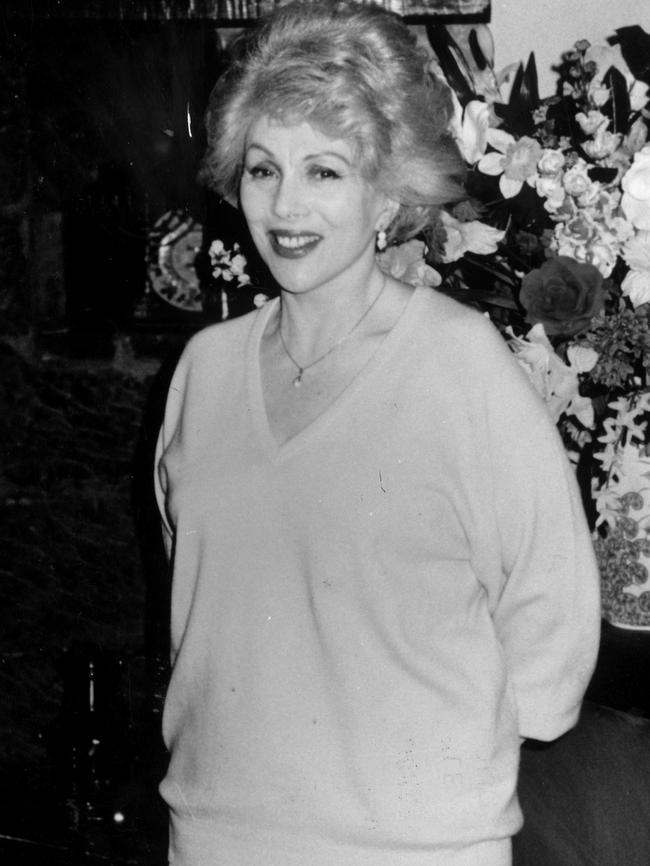
Police document reveals secret world of Hells Angels
In 2016 a 25-page statement, prepared by police intelligence analysts for a trial is revealed and it gives a rare look inside the bikie gang.
It detailed how if a member is wearing a patch with the words “filthy few” it means they have committed an extreme act of violence like murder.
A patch with “Dequaillo” means the member has assaulted a police officer.
“Only a handful of Hells Angels members are permitted to wear the words Hells Angels or the ‘winged dead head’,” the document said.
“These words and images are not only trademarked, providing a legal recourse to the Hells Angels for infringements, there has been a history of unauthorised persons using the words or symbols being seriously assaulted … including tattoos being forcibly taken from them.”
Hells Angels cancel run after standoff
In February last year the Hells Angels cancelled their national run after a bizarre standoff on a houseboat in Mildura with a police strike that was intent on dismantling them.
The tense exchange took place as between 40 and 60 members of the Hells Angels gathered for their biggest annual party.
The group included presidents, sergeants-at-arms, treasurers, new blood and old.
They had hired a houseboat, complete with red leather seating, a spa and loud music to cruise the river. A party on water is harder to raid and the group wanted peace and privacy.
But a convoy of cops arrived, photographing the boat and the men on board, writing down names.
They eventually forced the bikies off the boat.
Police then continued to pursue the Hells Angels in Mildura, eventually forcing so many to leave town that the national run got cancelled.

Ball Bearing dies in crash
In March founding Hells Angels member Chris “Ball Bearing” Coelho died in a crash near Kew.
Coelho was an integral part of the Hells Angels legendary rock n’ roll festivals in Broadford.
He gained his “Ball Bearing’’ nickname during his early years as an outlaw bikie, when he wore a chrome helmet and it stuck.
Coelho lived through an internal Hells Angels split that turned violent over the production of speed.

He would survive the conflict, but not before he was shot in the chest.
Aged 68 Coelho retired from the Hells Angels in 2012 after 42 years membership of the world’s most infamous outlaw motorcycle club.
His wife, Dee said he would be remembered for the mark he left, especially on the Australian music scene.
“He lived a great life. Chris was a wonderful and genuine man. He took part in life and lived it to the fullest,” she said.
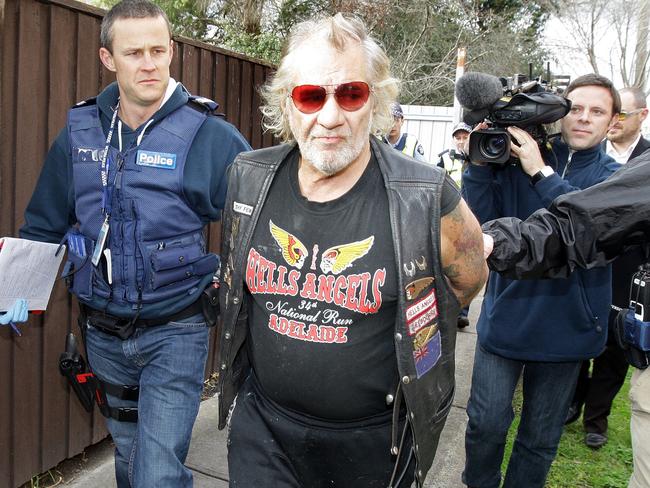
In Melbourne today
Melbourne’s original outlaw bikie club still has clubhouses and bike “runs”.
But it is understood numbers in recent runs, including the national run at Lorne earlier this year, have been lower than usual.
Unlike other clubs, the world’s most infamous club refuses to have any dialogue with police.
The Angels, of late, have kept out of the headlines.
They are no longer believed to be on the list of suspects of putting the sergeant-at-arms of the re-emerging Finks gang in a Frankston hospital last month.
In Melbourne’s north, East County chapter’s most notorious member, Peter “Skitzo” Hewat, remains an ominous player in the towing industry.
Sources tell the Herald Sun Hewat has acquired a new heavy-haulage tow truck — despite not owning a heavy-haulage licence — and intimidates rivals.
The Hells Angels’ links to a prominent Middle Eastern Melbourne crime family have now ceased. That partnership was evident at funerals and gatherings and detected by police in phone taps.
Other bikie gangs
THE COMANCHERO: THE MOST VICIOUS BIKIE CLUB
THE BANDIDOS: HOW THEY WERE BORN
THE REBELS: POWER VACUUM WEAKENED THEIR EMPIRE
THE FINKS: THE RULES THEY HAVE TO FOLLOW
Originally published as Inside the Hells Angels: What you need to know about the world’s biggest outlaw bikie gang


